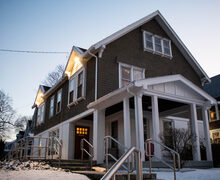Future of Interstate 81 discussed at Syracuse open house hosted by state officials
Ally Moreo | Asst. Photo Editor
The community grid option would provide a safer route for people going from downtown to the Syracuse University area, said Bob Dougherty, a representative from Bike CNY.
Digital renderings, display boards and illustrative plans of future Interstate 81 were presented during a neighborhood meeting at Dr. King Elementary School Thursday evening.
The New York State Department of Transportation held an open-house meeting to further explain the latest developments in the I-81 project to community members a viaduct alternative that would replace the existing I-81 and reconstruct a wider I-81, as well as a community grid option that would convert the existing highway to a surface street with bicycle and pedestrian amenities.
Gene Cilento, public information officer for the DOT, said the viaduct option will modernize the existing elevated I-81 and rebuild a similar interstate with some geometric changes. He added that some improvements will also be made to several exits.
With the community grid choice, Cilento said the elevated portion of the I-81 will be removed, which would change the traffic pattern heading up to the University Hill and hospital areas. Removing Exit 18, which leads to Adams and Harrison streets, means the primary entrance point to those areas will be affected, he said.
One of the concerns with the community grid option is that some people might not get used to a new and broader street network after more than 50 years of the same commuting path, Cilento said.
“The community grid introduces a whole new different traffic pattern that people would have to get used to it,” Cilento said. “That would be a significant change that would take time.”
With the elevated highway option, Cilento said more building acquisitions will take place to make room for rebuilding a straighter and wider viaduct to meet the Federal Highway Administration’s standards.
Bob Dougherty, a representative from Bike CNY, said he thinks the community grid option would be the best because it will provide a much safer route for people going from downtown to the Syracuse University area.
“Right now you take the life in your hand,” Dougherty said. “I saw a lot of medical students running across the street all the time.”
From the economic development standpoint, he said more buildings can be built along the Almond Street area with the community grid option.
Dougherty hopes to see a similar plan with a street level boulevard, comparing with the idea of extending the Onondaga Creekwalk to construct a bicycle trail, he said.
Bob Haley, an architect and a volunteer in the I-81 project, said the DOT has done a great job in developing the community grid.
“They have found a way to utilize the city streets in an efficient way to slow down the speed and provide more choices for people to get to their destinations,” Haley said.
The community grid option, he said, reduces a lot of cost for building a new viaduct and shortens the construction period, causing less damage to the businesses.
“When we get unused lands back from the DOT, that goes back into the city and the county,” Haley said. “(That) added to the adjacent properties and create new properties, and new buildings, new leases, new tenants, new businesses and new residences will get back.”
He added that the economic differences are huge with the two options to the future I-81. Haley said if the new viaduct is built, it will create more negative impacts on the city because it reduces the property values near and along the edges of the entire bridge.
“It’s not just about the initial cost,” He said. “It’s about the long-term cost in the city’s context.”
The estimated cost of the viaduct and the community grid alternative, including preliminary property acquisition costs, is $1.7 billion and $1.3 billion, respectively, according to the DOT.
Published on November 4, 2016 at 12:51 am
Contact Chieh: chchen@syr.edu





